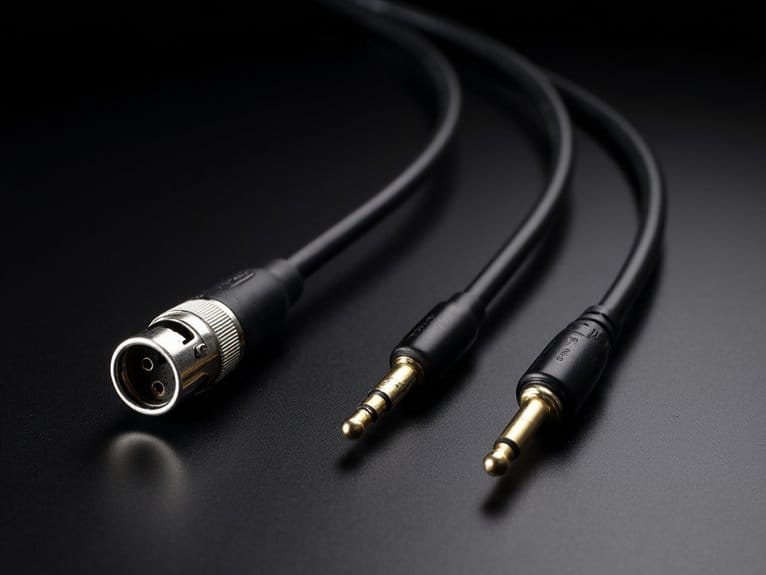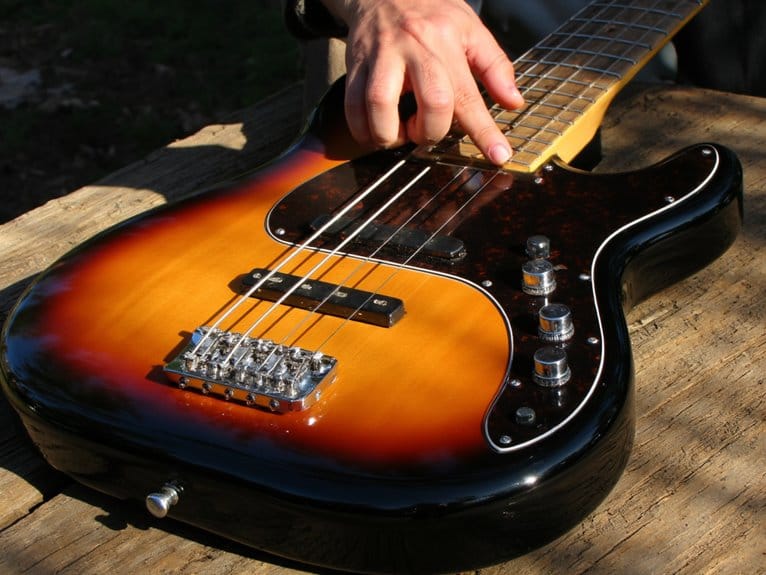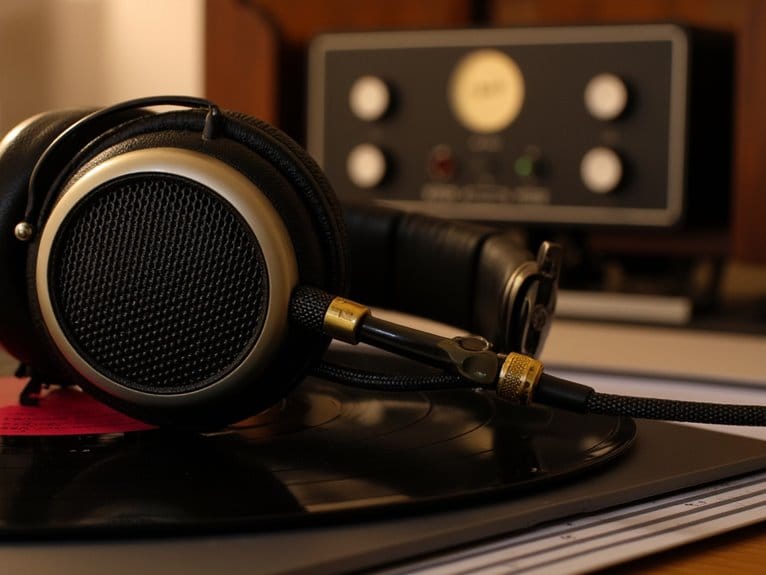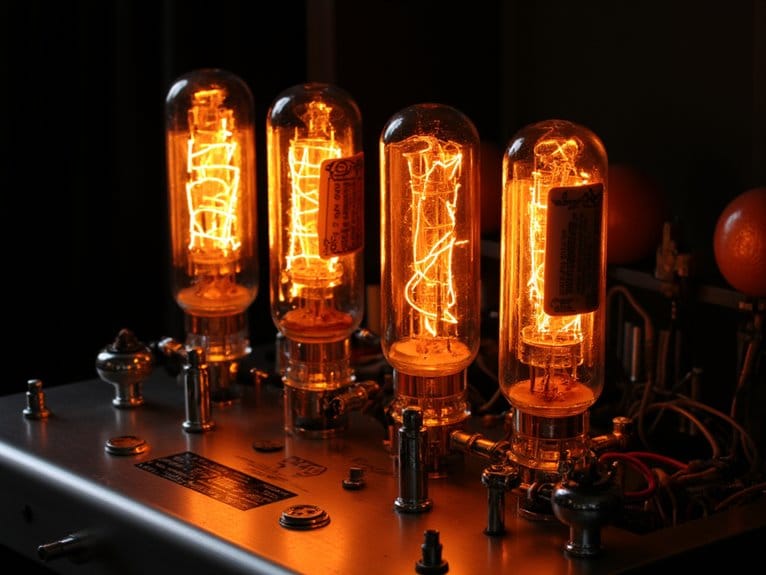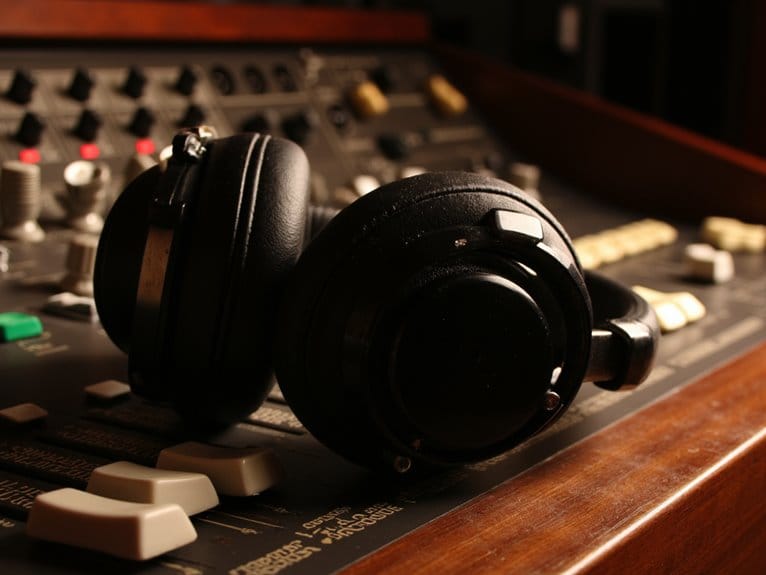Understanding Audio Cable Types: XLR, TRS, TS Explained
You’ll encounter three primary audio cable types in any recording setup—XLR, TRS, and TS—each engineered with distinct conductor configurations that dramatically impact signal quality. XLR cables feature three-pin balanced designs with locking mechanisms, perfect for professional microphones requiring phantom power, while TRS cables utilize three conductors for balanced mono or stereo transmission between mixers and monitors. TS cables offer simple two-conductor unbalanced connections ideal for instruments under twenty feet, though they’re susceptible to electromagnetic interference over longer runs. Understanding these fundamental differences will transform your audio setup decisions.
We are supported by our audience. When you purchase through links on our site, we may earn an affiliate commission, at no extra cost for you. Learn more.
Notable Insights
- XLR cables feature three-pin balanced design with locking mechanism, ideal for professional microphones and phantom power applications.
- TRS cables have three conductors supporting balanced mono or stereo signals with superior noise rejection over long distances.
- TS cables use simple two-conductor unbalanced design, best for short instrument connections under 20 feet due to noise susceptibility.
- Balanced cables (XLR/TRS) cancel electromagnetic interference using differential signaling, while unbalanced cables (TS) lack this protection mechanism.
- XLR suits professional studio/live environments, TRS works for mixer-to-monitor connections, TS handles basic instrument-to-amplifier links effectively.
XLR Cable Design and Professional Applications
When you’re dealing with professional audio equipment, XLR cables represent the gold standard for reliable signal transmission, and I’ve found their three-pin balanced design consistently delivers clean audio even in the most challenging environments.
The XLR connector construction features a robust metal shell with a locking mechanism that prevents accidental disconnections, which I’ll admit has saved me from several embarrassing moments during live performances. These cables utilize oxygen-free copper construction to ensure optimal signal clarity and reduced resistance in the transmission path. Quality XLR cables incorporate gold-plated connectors that enhance durability and provide superior corrosion resistance for long-term reliability in professional studio environments.
Professional audio applications rely heavily on XLR’s ability to carry both audio signals and phantom power simultaneously, eliminating the need for separate power cables when connecting condenser microphones to mixing consoles, audio interfaces, and recording equipment in studios where signal integrity matters most. Modern audio interfaces like those from Focusrite and PreSonus feature XLR inputs with phantom power capabilities, making them essential for professional home recording setups. The balanced audio transmission minimizes noise and interference through superior electromagnetic interference rejection, making XLR connectors essential for maintaining pristine signal quality over longer cable runs in professional environments. Most affordable interfaces provide 48V phantom power as a standard feature for condenser microphones, ensuring compatibility with professional-grade recording equipment.
TRS Cable Construction and Balanced Audio Benefits
You’ll find TRS cables offer a significant upgrade from basic TS connections through their three-conductor design, which includes tip, ring, and sleeve sections separated by insulating rings that enable both balanced mono and stereo transmission capabilities.
The physical construction utilizes two internal signal wires plus a dedicated ground shield, allowing these cables to carry differential signals that naturally cancel out electromagnetic interference and noise picked up during transmission.
When you’re working with professional audio equipment, mixers, or audio interfaces, this balanced design becomes essential because it maintains signal clarity over long cable runs while dramatically reducing the hum and interference that plague unbalanced connections. Professional-grade models feature Neutrik® connectors that provide superior durability and connection reliability compared to standard consumer-grade alternatives.
TRS Physical Design Elements
The architecture of TRS cables represents one of audio engineering’s most elegant solutions, where three distinct conductors—the tip, ring, and sleeve—work together within a single connector to deliver superior sound quality. Understanding these connector types helps you choose the right TRS cable for your equipment.
| Component | Function | Physical Characteristic |
|---|---|---|
| Tip | Primary audio signal | Pointed metal end |
| Ring | Second conductor | Metal band behind tip |
| Sleeve | Ground/return path | Longest metal section |
Each element’s physical design serves a specific purpose. The tip carries your main signal, while the ring enables stereo or balanced configurations. Insulating rings between conductors prevent short circuits, and the sleeve provides essential grounding. This thoughtful construction, combined with strain relief and durable materials like copper conductors and PVC jacketing, guarantees reliable performance. Professional-grade cables often feature oxygen-free copper construction and gold-plated connectors, which significantly enhance signal integrity and reduce corrosion over time.
Noise Rejection Advantages
While most audio enthusiasts focus on frequency response and impedance ratings, I’ve discovered that the real game-changer in professional audio lies within TRS cables’ sophisticated noise rejection capabilities, which stem from their balanced audio design that fundamentally transforms how signals travel through your equipment chain.
Here’s why balanced TRS cables will revolutionize your audio experience:
- Eliminate ground loops that create annoying hum and buzz in your recordings
- Maintain pristine signal quality over long cable runs without degradation
- Cancel electromagnetic interference from nearby equipment and lighting systems
- Achieve professional-grade audio clarity that rivals expensive studio setups
Through differential amplification and common-mode rejection, these cables use cable shielding alongside dual signal conductors to subtract noise while doubling your desired audio signal, delivering remarkably clean sound reproduction.
Quality XLR cables can effectively run up to 300 feet while maintaining signal integrity, though under 200 feet is recommended for optimal performance. Professional audio interfaces utilize these balanced connections to achieve ultra-low latency performance for real-time monitoring and recording applications.
This balanced signal technology is essential for acoustic guitar applications, where DI boxes convert unbalanced instrument signals to balanced XLR output to eliminate hum and noise in both studio recordings and live performances.
TS Cable Simplicity for Instrument Connections
When I first started working with audio equipment, I quickly learned that TS cables represent the backbone of most instrument setups, offering a revitalizing straightforward solution for connecting guitars, basses, and keyboards to amplifiers or effects pedals.
You’ll find TS cable advantages include their simple two-conductor design, minimizing failure points, cost-effectiveness, and universal compatibility with standard instrument inputs.
However, TS cable disadvantages center on their unbalanced signal transmission, making them susceptible to noise over long runs.
TS cable applications excel in mono instrument connections under 20 feet, while TS cable limitations prevent their use with balanced or stereo equipment.
This simplicity makes them perfect for straightforward signal chains where reliability matters most.
Balanced Versus Unbalanced Signal Transmission
When you’re comparing balanced and unbalanced signal transmission, you’ll discover that the fundamental difference lies in how each system handles the inevitable electrical interference that threatens your audio quality.
I’ve found that balanced cables employ a clever polarity-reversal technique, where identical signals travel through two conductors with opposite phases, then get combined at the receiving end to cancel out any noise picked up during transmission.
Your unbalanced cables, while simpler and more common in consumer gear, rely solely on shielding to protect the single signal conductor, making them considerably more vulnerable to electromagnetic interference, radio frequency noise, and that annoying hum you’ve probably experienced in longer cable runs. This is why dual-shield designs are particularly important for maintaining clean signal transmission in professional audio applications.
Professional recording setups often require zero-latency monitoring through dedicated headphone outputs to maintain timing accuracy during signal transmission.
The quality of materials used in cable construction, such as oxygen-free copper wiring, can significantly improve conductivity and reduce static noise in both balanced and unbalanced configurations.
Noise Rejection Mechanisms
Since I’ve spent years untangling audio mysteries in both home studios and professional venues, I can tell you that understanding noise rejection mechanisms represents the most crucial difference between balanced and unbalanced signal transmission—a distinction that’ll either make your audio pristine or plagued with unwanted interference.
Here’s why balanced cables deliver superior noise immunity and signal interference protection:
- Differential signaling cancels common-mode noise picked up equally on both conductors, eliminating hums and buzzes that would otherwise ruin your recordings.
- Three-conductor design creates an inherent shield against electromagnetic interference that single-wire unbalanced cables simply can’t match.
- Professional reliability over distances exceeding 200 feet, while unbalanced cables deteriorate after just 10 meters.
- Environmental resilience in RF-heavy venues where unbalanced connections would crackle with interference.
When connecting instruments to mixing boards or audio interfaces, ground lift switches on DI boxes provide an essential backup mechanism for eliminating stubborn ground loops that can persist even with balanced connections. Professional audio interfaces with ultra-low-noise preamps further enhance signal quality by maintaining the cleanest possible path from microphone to recording device. Whether you’re using cardioid microphones in untreated spaces or working with condenser mics in professional studios, the cable choice directly impacts your final audio quality.
Signal Quality Differences
Beyond these protective mechanisms, the actual signal quality delivered by balanced and unbalanced cables reveals stark differences that become immediately apparent when you’re monitoring audio through professional headphones or studio monitors.
You’ll notice that balanced cables maintain pristine audio fidelity across the entire signal path, delivering clarity that’s essential for critical listening environments where every nuance matters.
Unbalanced cables, while perfectly adequate for casual listening, introduce subtle coloration and distortion that becomes more pronounced with longer runs or in environments with significant audio interference.
The differential signaling in balanced systems creates a noise-free transmission that preserves dynamic range and frequency response, while unbalanced connections can suffer from hum, buzz, and electromagnetic contamination that degrades your audio quality noticeably.
Professional musicians understand that oxygen-free copper conductors play a crucial role in maintaining signal clarity by reducing resistance and minimizing unwanted noise in their audio transmission chains.
Similar to how spring tension affects responsiveness in drum pedal systems, the physical characteristics of cable construction directly influence the speed and accuracy of audio signal transmission through your equipment chain.
Physical Connector Characteristics and Identification
The most reliable way I’ve found to identify different audio connector types involves examining their physical structure, since each connector’s design reflects its specific electrical purpose and intended application.
When you’re dealing with various connector types, understanding their visual cues helps you quickly determine which audio signals they’ll handle effectively.
Here’s what I look for when identifying connectors:
- Count the insulating rings – TS has one black ring, TRS has two distinctive rings separating three metal segments.
- Check the overall size and shape – XLR connectors feature robust cylindrical metal shells with visible pin arrangements inside.
- Test the insertion feel – TRS connectors provide two distinct clicks during insertion, while TS gives just one.
- Look for locking mechanisms – XLR cables lock securely and require latch release for removal.
Optimal Use Cases for Each Cable Type
When you’re choosing the right audio cable for your specific application, I’ve learned that matching the connector type to your actual needs makes a dramatic difference in both sound quality and reliability.
XLR cables excel in professional environments like recording studios and live performances, where their locking mechanism and cable durability handle demanding conditions while delivering phantom power to microphones.
TRS cables work brilliantly for balanced line connections between mixers and studio monitors, plus they’re versatile enough to carry stereo signals in compact setups.
TS cables remain my go-to choice for instrument connections, despite their unbalanced limitations on longer runs.
For streaming setups specifically, XLR inputs with 48V phantom power support professional condenser microphones and provide the foundation for broadcast-quality audio that distinguishes serious content creators from casual users.
Each connector variation serves specific purposes, so understanding your environment’s requirements—whether it’s interference rejection, portability, or budget constraints—helps you make the right choice.
Noise Reduction and Signal Quality Considerations
Although cable selection gets most of the attention, I’ve discovered that understanding noise reduction principles fundamentally changes how you’ll approach audio signal quality in your setup.
Cable shielding becomes your first line of defense against electromagnetic interference, while proper noise isolation techniques protect those delicate low-level signals from getting corrupted.
Balanced cables like XLR naturally reject interference through differential signaling, whereas unbalanced TS cables struggle with noise over longer runs.
Here’s what dramatically impacts your signal quality:
- Multiple shielding layers create an impenetrable barrier against EMI invasion
- Proper grounding techniques eliminate that annoying hum before it starts
- Strategic cable placement away from power sources protects signal integrity
- Quality connector construction maintains clean signal paths throughout your chain
Professional preamps with a noise floor of -120dB or better ensure that your carefully selected cables can deliver the cleanest possible signal to your recording interface.
Frequently Asked Questions
Can I Use XLR to TRS Adapters Without Losing Audio Quality?
You can use XLR to TRS adapters without losing audio quality if they’re properly wired and high-quality. Good adapter performance maintains balanced signals, while poor wiring creates audio impedance mismatches that degrade sound.
What’s the Maximum Cable Length Before Signal Degradation Becomes Noticeable?
Maximum cable length before noticeable signal loss depends on your cable type. You’ll see degradation around 50 feet for TRS/TS cables, while XLR microphone cables maintain quality up to 100 feet before requiring boosters.
Are Expensive Audio Cables Worth the Investment Over Budget Options?
You’ll find expensive cables offer better cable construction materials and durability, but budget audio performance often matches premium options in home studios. Invest selectively in high-quality cables only for critical professional applications.
Can Phantom Power Damage Equipment When Using Different Cable Types?
You’ll face phantom power risks when using wrong cable types. Unbalanced TS cables create cable compatibility issues that can damage equipment through electrical shorts, while balanced XLR cables safely handle phantom power without problems.
Do Gold-Plated Connectors Actually Improve Sound Quality or Just Durability?
Gold plating benefits are primarily durability-focused rather than sound quality improvements. You’ll get better connector corrosion resistance and long-term reliability, but won’t hear noticeable audio differences compared to quality non-gold connectors.
On a final note
You’ll find that choosing the right cable becomes second nature once you understand their core differences. XLR‘s your go-to for professional microphones and balanced line signals, TRS handles stereo connections and balanced mono beautifully, while TS keeps things simple for guitars and unbalanced gear. Don’t overthink it—match the connector to your equipment’s needs, prioritize balanced connections when possible for cleaner audio, and you’ll avoid most common signal issues.

